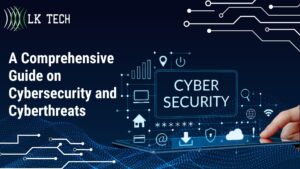Cybersecurity: A Comprehensive Guide
Cybersecurity is more crucial than ever for organizations to understand and implement effectively. As digital transformation accelerates, so do the risks of cyber threats that can cripple operations and damage reputations. This article will provide a comprehensive guide to cybersecurity, drawing key information from the LK Technologies website. LK Technologies is a leading IT services company helping organizations across Cincinnati fortify their cybersecurity.

- A Comprehensive Guide on Cybersecurity and Cyberthreats
Defining Cybersecurity and Its Importance
Cybersecurity refers to practices and technologies for defending systems, networks, devices, programs, and data from digital attacks. It starts with preventing unauthorized access that could enable cybercrime like data breaches, malware infections, and denial-of-service attacks. Robust cybersecurity is essential today, since negligence makes sensitive information vulnerable. Customers also expect data protection amid rising awareness of cyber risks.
With more business functions being digitized, vast amounts of sensitive data are stored online and accessed through digital channels. This expands the attack surface for cybercriminals seeking to infiltrate systems and steal valuable data. A breach can result in substantial financial losses, legal liabilities, and reputational damage. Implementing cybersecurity controls is no longer an option, but a necessity for organizational success.
Major Types of Cyber Threats and Prevention
Several prevalent cyber threats that LK Technologies helps clients combat include:
Malware like ransomware, viruses and Trojans
Malware refers to malicious software designed to infect systems and damage or gain access to data. Examples include ransomware that encrypts files until a ransom is paid, viruses that replicate to damage systems, and Trojans that disguise as legitimate programs. Solutions involve using reputable antivirus software, implementing multifactor authentication, training employees to avoid suspicious downloads, and patching known vulnerabilities promptly.
Distributed denial-of-service (DDoS) attacks that overload systems
DDoS attacks aim to overwhelm systems by flooding them with more traffic than they can handle, rendering them inaccessible to legitimate users. Common prevention methods include firewalls, VPN connections, load balancing, and working with internet service providers to filter out malicious traffic.
Social engineering through manipulation
Social engineering relies on manipulating people psychologically to divulge sensitive information or perform harmful actions. Training employees in emotional intelligence helps them recognize deception tactics and resist manipulation. Strict policies on sharing corporate data also limit damage from social engineering.
Phishing using emails mimicking trusted sources
Phishing uses emails designed to impersonate trusted sources like colleagues or vendors to trick recipients into sharing login credentials or sensitive data. Employee education on spotting phishing attempts is critical. Policies requiring all corporate emails to come from official domains also help curb phishing.
Man-in-the-middle attacks intercepting data transfers
These attacks infiltrate the communication between two parties and intercept sensitive data being transferred. Avoiding public Wi-Fi and using encrypted HTTPS protocol boosts security against such attacks.
Password attacks via guessing, spying, and databases
Hackers can guess weak passwords, spy on users as they log in, or steal password databases. Using strong unique passwords per account and installing keylogging protections are key defenses.
SQL injection inserting malicious SQL code
SQL injection aims to manipulate backend SQL database queries by inserting malicious code into input fields like search bars. Input validation and firewalls help counter SQL injection attempts.
Implementing Cybersecurity Controls
Examples of cybersecurity controls LK Technologies recommends include:
Access management
- Revoking access when employees leave, securing devices physically, requiring strong passwords, and disposing of data securely.
Training and Awareness
- Backing up critical data off-site and training staff on threats like social engineering.
Ongoing audits and guidelines
- Regularly reviewing access lists and using technical guidelines to ensure robust security.
Risk assessments
Ongoing awareness training, audits, and risk assessments are also vital for proactively identifying vulnerabilities. Assessments should analyze risks from internal processes, external threats, and system configurations.
Data protection
- Encrypting data end-to-end and implementing data loss prevention controls.
- Anonymizing or pseudonymizing data where possible to minimize damage if stolen.
Incident response
- Having an incident response plan for detecting, containing, and recovering from breaches quickly.
- Working with cybersecurity partners to augment internal response capabilities.
Governing Cybersecurity Holistically
For optimal cybersecurity, LK Technologies advises looking beyond technical controls to governance. This means establishing frameworks spanning risk management, compliance, data protection, and incident response. Such strategic oversight ensures controls align with business needs and adapt to the evolving threat landscape. It also fosters a cybersecurity-focused culture.
Risk management
A risk management framework entails continuously identifying, assessing, and mitigating cyber risks based on their likelihood and potential impact. Cyber risks are prioritized and addressed according to severity.
Compliance
Regulatory compliance ensures cybersecurity policies and controls meet legal obligations and industry standards. This protects the organization from penalties in case of a breach.
Data protection
A data protection framework focuses on properly classifying data based on sensitivity, and applying corresponding controls for security, access, and retention.
Incident response
Incident response plans ensure the organization can quickly detect, analyze, contain, and recover from cyberattacks to minimize their impact.
Creating a Cybersecurity-Focused Culture
Technical controls are only as effective as the people using them. Fostering an organizational culture focused on cybersecurity is thus critical. Steps organizations can take include:
- Making cybersecurity a collective responsibility across departments, not just the IT team’s job.
- Providing ongoing cybersecurity training to all employees, tailored to their roles.
- Rewarding cyber risk-mitigating behaviors like reporting phishing emails.
- Ensuring leadership consistently prioritizes cybersecurity in communications and decision-making.
- Service providers like LK Technologies are hired to validate in-house efforts using external expertise.
Conclusion
Effective cybersecurity requires layered technical controls as well as governance for a holistic approach. Heeding LK Technologies' advice can help organizations in the Cincinnati region avoid cyber disruptions, safeguard reputations, and focus on success.
With robust cybersecurity managed by a trusted IT services partner, organizations can confidently embrace digital transformation. The threat landscape will only intensify, so implementing comprehensive cybersecurity is an investment in the organization's future.


